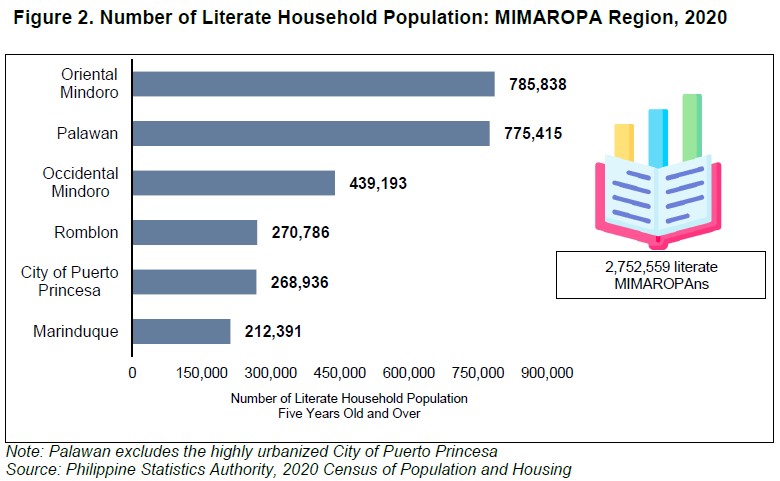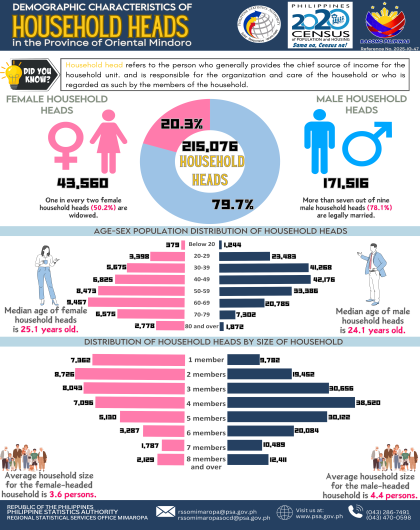SPECIAL RELEASE
Literacy Rate Among Household Population Five Years Old and Over in Oriental Mindoro
(2020 Census of Population and Housing)
Literacy rate in Oriental Mindoro reaches 96.5 percent
Based on the 2020 Census of Population and Housing (2020 CPH), of the 814,135 household population five years old and over in Oriental Mindoro, 785,838 persons (96.5 percent) were literate. In the 2020 CPH, a person is considered literate if he/she is able to read and write a simple message in any language or dialect.
The provincial literacy rate in 2020 was 0.9 percentage point higher than the regional literacy rate of 95.6 percent. In terms of sex, female’s literacy rate in 2020 at 96.7 percent was slightly higher than the literacy of males at 96.4 percent. (Figure 1 and Table 1)

Literacy rate is highest among household population 15 to 19 years old
In Oriental Mindoro, the literacy rate is highest among household population whose age is 15 to 19 years old at 99.0 percent. The same age group had the highest literacy rate for male household population (98.9 percent) and female household population (99.1 percent). The age groups 10 to 14 years old and 20 to 24 years old closely followed with corresponding literacy rate of 98.8 percent (male: 98.6 percent, and female: 99.0 percent) and 98.6 percent (male: 98.5 percent, and female: 98.7 percent). (Table 1)

On the other hand, senior citizens and children belonging to the age group of five to nine years old had low literacy rates. The literacy rate among household population 60 to 64 years old was at 96.7 percent with females (96.9 percent) had a higher literacy rate than males (96.5 percent). Likewise for the household population 65 years and over at 94.2 percent literacy rate (male: 93.9 percent, and female: 94.4 percent). (Table 1)
Meanwhile, children whose age is between five to nine years old had 87.8 percent literacy rate with male’s literacy rate of 87.4 percent fared lower than female’s literacy rate of 88.3 percent. (Table 1)
Almost three in every ten literate MIMAROPAns reside in Oriental Mindoro
Among provinces in MIMAROPA region, Oriental Mindoro had the highest number of literate household population whose age is at least five years old. This number reached 785,838 persons or 28.5 percent of the region’s literate household population five years old and over. The province of Palawan closely followed with 775,415 persons which translates to a 28.2 percent of the regional number of literate household population. Meanwhile, the province of Marinduque had the least number of literate population at 212,391 persons. (Figure 2)

Number of literate males is higher than the number of literate females
In terms of the number of literate household population five years old and over by sex, male household population outnumbered female household population in the province with a share of 50.4 percent. The same trend holds for all municipalities in the province wherein the highest share of literate males in the municipal literate household population was at San Teodoro, Pola and Baco having the same 51.1 percent share.
On the other hand, City of Calapan the literate female household population had a share of 50.4 percent to the total literate household population in the city.

Literacy rate is highest in the City of Calapan
Among one city and 14 municipalities in the province, the City of Calapan posted the highest literacy rate at 98.6 percent. This was translated from the city’s 130,215 literate household population aged five years old and over out of 132,026 household population whose age is at least five years old. Aside from the City of Calapan, seven municipalities had a literacy rate higher than the provincial rate (96.5 percent), namely: Pola (98.3 percent), Pinamalayan (98.1 percent), Victoria (97.2 percent), Gloria (97.2 percent), Socorro (97.0 percent), and Puerto Galera (96.9 percent). Meanwhile, Bulalacao had the lowest literacy rate at 92.3 percent. (Table 2)
In terms of sex, female’s literacy rate in all city and municipalities of the province except Pola and San Teodoro was slightly higher that the literacy of males. The largest difference on the literacy rate by sex was observed in the municipality of Bansud with female’s literacy rate higher by nearly 0.7 percentage point than males’ literacy rate. On the other hand, the literacy rate among males was higher than the literacy rate among females by 0.1 percentage point in the municipalities of Pola and San Teodoro. (Table 2)

The statistics presented in this Special Release were based on the information provided by the respondent or any responsible household member who provided answers to the questions and gave information about all the household members.
For the 2020 CPH, literacy data of household members five years old and over were collected by asking the respondents, “Can ___ read and write simple message in any language or dialect?”.
(SGD) CHARLYN ROMERO-CANTOS, PhD
(Chief Administrative Officer)
Officer-in-Charge
Oriental Mindoro Provincial Statistical Office
HTD/JGO
TECHNICAL NOTES
II. Introduction
The Philippine Statistics Authority (PSA) conducted the 2020 Census of Population and Housing (2020 CPH) in September 2020, with 01 May 2020 as reference date.
The 2020 CPH was the 15th census of population and 7th census of housing that was undertaken in the Philippines since the first census in 1903. It was designed to take an inventory of the total population and housing units in the country and collect information about their characteristics.
The Philippine Standard Geographic Codes as of April 2022 was used for the disaggregation of geographic levels of the 2020 CPH.
II. Data Collection
Data on literacy provides an important indicator that will serve as guide to planners in formulating policies and programs for the development of the country’s educational system.
The statistics presented in this report were based on the information provided by the respondent or any responsible household member who may provide accurate answers to the questions and give correct information about all the household members; hence, it should be used with caution.
III. Methodology
The population and housing censuses in the Philippines are conducted on a “de jure” basis, wherein a person is counted in the usual place of residence or the place where the person usually resides. The enumeration of the population and collection of pertinent data in the 2020 CPH referred to all living persons as of 01 May 2020.
The population and housing censuses in the Philippines are conducted on a “de jure” basis, wherein a person is counted in the usual place of residence or the place where the person usually resides. The enumeration of the population and collection of pertinent data in the 2020 CPH referred to all living persons as of 01 May 2020.
IV. Concepts and Definition of Terms
Household is a social unit consisting of a person or a group of persons who sleep in the same housing unit and have a common arrangement in the preparation and consumption of food.
Household population refers to all persons who are members of the household.
Sex is the biological and physiological reality of being a male or female.
Age refers to interval of time between the person’s date of birth and his/her last birthday prior to the census reference date. It is expressed in completed years or whole number.
Simple literacy is the ability of a person to read and write a simple message. As such, a person is said to be literate if he/she can both read and write a simple message in any language or dialect. A person who cannot read and write a simple message, such as “I CAN READ” is considered illiterate. Moreover, a person is still considered illiterate if he/she is capable of reading and writing only his/her own name or numbers. Similarly, a person is illiterate if he/she can read but not write or he/she can write but not read.
A person who knows how to read and write but at the time of the census can no longer read and/or write due to some physical defect or illness is still considered literate. Example of this is an aged person who knows how to read and write but can no longer perform these activities due to poor eyesight or hand injury. Persons with disability who can read and write through other means such as the use of Braille are considered literate.






